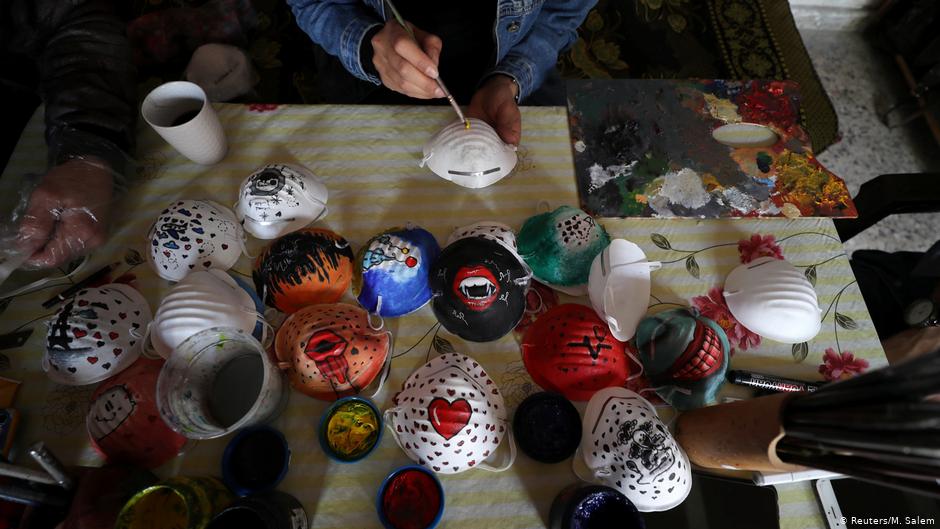Coronavirus and the face masks made in Gaza

The plaster is crumbling off the walls of the workshops, the machines are obsolete and the workers underpaid. But in recent weeks, production has been at maximum capacity in Gaza’s textile factories for the first time following decades of decline. They have been manufacturing face masks, hospital gowns and protective clothing more or less around the clock, not only to meet domestic demand, but also for export to Israel and all over the world.
As a result of the COVID-10 pandemic, the Palestinian textile industry has experienced a flood of orders. Seventy percent of the factory workshops are now exclusively producing equipment to protect against the virus, reports Nabil Bawab, head of Unipal 2000, one of the largest companies in the Gaza Strip, which currently employs 600 workers. Even small tailor shops are working to capacity. Many have doubled their production, claims Omaar Shaban, a political economist and director of PalThink. The Palestinian agricultural sector has also profited from the corona crisis, as it has greatly increased production of fresh vegetables for the Israeli market.
The strict cordoning off of Gaza, initiated after Hamas came to power in June 2007, has been intensified since the outbreak of the coronavirus. Journalists are no longer allowed into Gaza and have to make do with telephone interviews. Almost daily, lines of trucks have choked the Kerem Shalom border crossing to transport raw materials for the textile factories and to deliver finished goods. Five million masks and 10,000 protective suits made in Gaza have already been exported in an effort, as Bawab, a company manager, proudly states, to "help all the countries of the world." The wages of those slaving away at the cutting tables and on the sewing machines, however, are very modest – between eight and 25 U.S. dollars a shift.
Keeping the virus in check
The upturn in the industry has hardly altered the miserable conditions in the narrow, overpopulated coastal strip. Around 75 percent of Gaza’s two million inhabitants have no steady income. “Even if a few thousand workers now have a job again, this is only a drop in the bucket,” says Hannes Alpen from the Palestine Office of the Friedrich Ebert Foundation. By comparison, in the years before the blockade, some 35,000 Palestinians were employed by the local textile industry.
[embed:render:embedded:node:39749]
Notwithstanding, one positive side-effect of Gaza’s isolation has been the low infection rate. There have only been 20 confirmed cases of COVID-19 and the feared epidemic spread of the virus in the refugee camps has yet to materialise, not least due to the efforts of the WHO, which has procured tests and has overseen the quarantine centres.
The Palestinian authorities have also managed to keep the spread of the virus under control on the West Bank through drastic curfew measures. There have only been four fatal cases amongst the over 520 confirmed cases of coronavirus, which, in comparison to other regions, seems quite low. The infection curve has remained flat. The government of the Palestinian Authority under Prime Minister Mohammed Shtayyeh has been credited for its managing of the situation. "Confidence in the government has risen dramatically," confirms Baschar al-Masri, head of the investment group Padico and founder of the newly built West Bank city of Rawabi.
Greater sense of self-initiative
The energetic Shtayyeh convinced the private sector from imposing layoffs in March and April and instead to pay workers half their wages. Tens of thousands of food packages for the needy were financed through donation campaigns. Overall, Palestinian civil society, already quite used to facing crises, developed an even greater sense of self-initiative. For instance, the Rawabi website launched a programme providing access to 500 globally offered digital courses ranging "from gardening to engineering studies at Columbia University," says Masri.
Yet, the tourism industry, Bethlehem’s life blood, has collapsed. Small businesses, which comprise up to ninety percent of the economy in the areas controlled by the Palestinian Authority, have been especially hard hit by six weeks of lockdown, even though regulations have since been relaxed. Prime Minister Shtayyeh anticipates a 20 percent decline in the national economy. The budget deficit of the Palestinian Authority already amounts to 1.4 billion U.S. dollars.
Since the start of May, some 50,000 Palestinians are once again permitted to work in Israel on construction sites and in the fields. The fear is, however, that along with their hard-earned money, workers will also be carrying the virus back home. Even though shoe factories in Hebron and small factories in Nablus have now switched to producing protective clothing, there is no denying the fact that without international support, Gaza and the West Bank will not manage to recover on their own.
Inge Gunther
© Qantara.de 2020
Translated from the German by John Bergeron